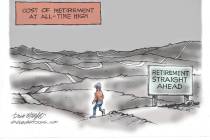COMMENTARY: The myth of American income stagnation
We aren’t stagnating, after all.
Unless you’ve been hibernating in the Himalayas, you must know of the recent surge in economic inequality. It’s not just that the rich are getting richer. The rest of us — say politicians, pundits and scholars — are stagnating. The top 1 percent have grabbed most income gains, while average Americans are stuck in mud.
Well, it’s not so. That’s the message — perhaps unintended — from the Congressional Budget Office, which reports periodically on the distribution and growth of the nation’s income. It recently found that most Americans had experienced clear-cut income gains since the early 1980s.
This conclusion is exceptionally important, because the CBO study is arguably the most comprehensive tabulation of U.S. incomes.
Most studies of incomes have glaring omissions. Some examine only before-tax income; others, after-tax. Many don’t include some government benefits. Others exclude employer-paid health insurance, which is a big item. The CBO study covers all these areas.
It confirms that the rich have catapulted ahead of most Americans. The richest 1 percent of households had average pretax incomes of $1.855 million in 2015. From 1979 to 2015, pre-tax incomes of the top 1 percent jumped 233 percent. That’s more than a tripling. (Figures reflect inflation.)
But it’s not true that no one else had gains.
The poorest fifth of Americans (a fifth is known as a “quintile”) enjoyed a roughly 80 percent post-tax income increase since 1979. The richest quintile — those just below the top 1 percent — had a similar gain of nearly 80 percent. The middle three quintiles achieved less, about a 50 percent rise in post-tax incomes.
These seem small, but over four decades, they’re meaningful. It’s doubtful that most Americans would prefer to revert to the world as it was in 1979 — a world without smartphones, the internet, most cable TV.
Why then the belief in stagnation?
One plausible theory is that the gains in any one year are so small that most people don’t recognize them. Instead, they feel they’re marching in place. The demands on their income — for housing, food, college tuition, vacations, etc. — swamp tiny gains.
Certainly, what’s occurring today is less impressive than the great gains of the 1950s and 1960s, when there was a flood tide of new technologies and products. But the modest income gains were widespread.
Although higher incomes could — in theory — reflect tax cuts, that doesn’t appear to be the case. In 2015, the richest 1 percent paid an average federal tax rate of 33 percent, close to the 1979 rate of 35 percent.
With income inequality rising, it’s not surprising that richer groups have actually provided an increasing share of federal tax revenues. In 2015, the richest quintile of Americans paid 69.5 percent of revenues, up from 55.1 percent in 1979. The share of the top 1 percent (included in the richest quintile) went from 14.1 percent in 1979 to 26.2 percent in 2015.
All the numbers seem complex and confusing. But piercing the statistical fog is essential to anchor our debates in reality and not in journalistic or political mythology. It may seem that, except for the fortunate few, hardly anyone is getting ahead. That’s convenient rhetoric, but it just ain’t so.
Robert Samuelson writes a column for The Washington Post.




























